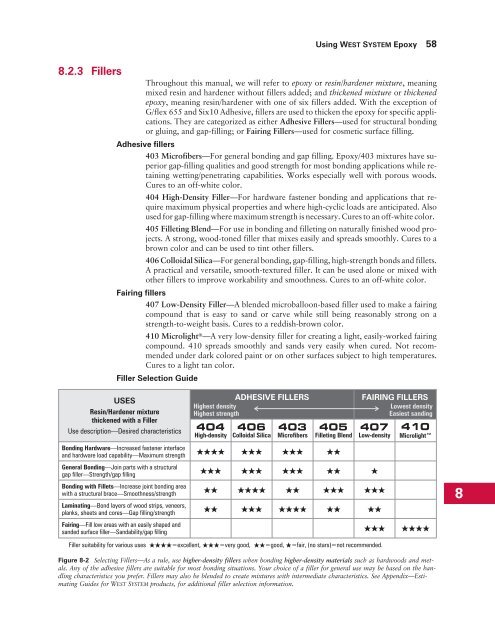Wooden Boat Restoration Repair - WEST SYSTEM Epoxy
Wooden Boat Restoration Repair - WEST SYSTEM Epoxy
Wooden Boat Restoration Repair - WEST SYSTEM Epoxy
Create successful ePaper yourself
Turn your PDF publications into a flip-book with our unique Google optimized e-Paper software.
8.2.3 Fillers<br />
Using <strong>WEST</strong> <strong>SYSTEM</strong> <strong>Epoxy</strong> 58<br />
Throughout this manual, we will refer to epoxy or resin/hardener mixture, meaning<br />
mixed resin and hardener without fillers added; and thickened mixture or thickened<br />
epoxy, meaning resin/hardener with one of six fillers added. With the exception of<br />
G/flex 655 and Six10 Adhesive, fillers are used to thicken the epoxy for specific applications.<br />
They are categorized as either Adhesive Fillers—used for structural bonding<br />
or gluing, and gap-filling; or Fairing Fillers—used for cosmetic surface filling.<br />
Adhesive fillers<br />
403 Microfibers—For general bonding and gap filling. <strong>Epoxy</strong>/403 mixtures have superior<br />
gap-filling qualities and good strength for most bonding applications while retaining<br />
wetting/penetrating capabilities. Works especially well with porous woods.<br />
Cures to an off-white color.<br />
404 High-Density Filler—For hardware fastener bonding and applications that require<br />
maximum physical properties and where high-cyclic loads are anticipated. Also<br />
used for gap-filling where maximum strength is necessary. Cures to an off-white color.<br />
405 Filleting Blend—For use in bonding and filleting on naturally finished wood projects.<br />
A strong, wood-toned filler that mixes easily and spreads smoothly. Cures to a<br />
brown color and can be used to tint other fillers.<br />
406 Colloidal Silica—For general bonding, gap-filling, high-strength bonds and fillets.<br />
A practical and versatile, smooth-textured filler. It can be used alone or mixed with<br />
other fillers to improve workability and smoothness. Cures to an off-white color.<br />
Fairing fillers<br />
407 Low-Density Filler—A blended microballoon-based filler used to make a fairing<br />
compound that is easy to sand or carve while still being reasonably strong on a<br />
strength-to-weight basis. Cures to a reddish-brown color.<br />
410 Microlight ® —A very low-density filler for creating a light, easily-worked fairing<br />
compound. 410 spreads smoothly and sands very easily when cured. Not recommended<br />
under dark colored paint or on other surfaces subject to high temperatures.<br />
Cures to a light tan color.<br />
Filler Selection Guide<br />
USES<br />
Resin/Hardener mixture<br />
thickened with a Filler<br />
Use description—Desired characteristics<br />
Bonding Hardware—Increased fastener interface<br />
and hardware load capability—Maximum strength<br />
Highest density<br />
Highest strength<br />
404<br />
High-density<br />
ADHESIVE FILLERS FAIRING FILLERS<br />
406<br />
Colloidal Silica<br />
403<br />
Microfibers<br />
405<br />
Filleting Blend<br />
<br />
407<br />
Low-density<br />
General Bonding—Join parts with a structural<br />
gap filler—Strength/gap filling <br />
Bonding with Fillets—Increase joint bonding area<br />
with a structural brace—Smoothness/strength <br />
Laminating—Bond layers of wood strips, veneers,<br />
planks, sheets and cores—Gap filling/strength <br />
Lowest density<br />
Easiest sanding<br />
410<br />
Microlight<br />
Fairing—Fill low areas with an easily shaped and<br />
sanded surface filler—Sandability/gap filling <br />
Filler suitability for various uses =excellent, =very good, =good, =fair, (no stars)=not recommended.<br />
Figure 8-2 Selecting Fillers—As a rule, use higher-density fillers when bonding higher-density materials such as hardwoods and metals.<br />
Any of the adhesive fillers are suitable for most bonding situations. Your choice of a filler for general use may be based on the handling<br />
characteristics you prefer. Fillers may also be blended to create mixtures with intermediate characteristics. See Appendix—Estimating<br />
Guides for <strong>WEST</strong> <strong>SYSTEM</strong> products, for additional filler selection information.<br />
8
















